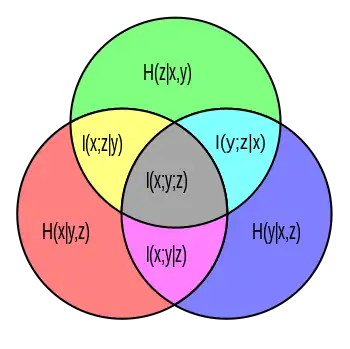Dual total correlation
In information theory, dual total correlation (Han 1978), information rate (Dubnov 2006), excess entropy (Olbrich 2008), or binding information (Abdallah and Plumbley 2010) is one of several known non-negative generalizations of mutual information. While total correlation is bounded by the sum entropies of the n elements, the dual total correlation is bounded by the joint-entropy of the n elements. Although well behaved, dual total correlation has received much less attention than the total correlation. A measure known as "TSE-complexity" defines a continuum between the total correlation and dual total correlation (Ay 2001).
Definition

For a set of n random variables , the dual total correlation is given by
where is the joint entropy of the variable set and is the conditional entropy of variable , given the rest.
Normalized
The dual total correlation normalized between [0,1] is simply the dual total correlation divided by its maximum value ,
Bounds
Dual total correlation is non-negative and bounded above by the joint entropy .
Secondly, Dual total correlation has a close relationship with total correlation, . In particular,
History
Han (1978) originally defined the dual total correlation as,
However Abdallah and Plumbley (2010) showed its equivalence to the easier-to-understand form of the joint entropy minus the sum of conditional entropies via the following:
References
- Han, Te Sun (1978). "Nonnegative entropy measures of multivariate symmetric correlations". Information and Control. 36 (2): 133–156. doi:10.1016/S0019-9958(78)90275-9.
- Fujishige, Satoru (1978). "Polymatroidal dependence structure of a set of random variables". Information and Control. 39: 55–72. doi:10.1016/S0019-9958(78)91063-X.
- Dubnov, Shlomo (2006). "Spectral Anticipations". Computer Music Journal. 30 (2): 63–83. doi:10.1162/comj.2006.30.2.63. S2CID 2202704.
- Olbrich, E.; Bertschinger, N.; Ay, N.; Jost, J. (2008). "How should complexity scale with system size?". The European Physical Journal B. 63 (3): 407–415. Bibcode:2008EPJB...63..407O. doi:10.1140/epjb/e2008-00134-9. S2CID 120391127.
- Abdallah, Samer A.; Plumbley, Mark D. (2010). "A measure of statistical complexity based on predictive information". arXiv:1012.1890v1 [math.ST].
- Nihat Ay, E. Olbrich, N. Bertschinger (2001). A unifying framework for complexity measures of finite systems. European Conference on Complex Systems. pdf.